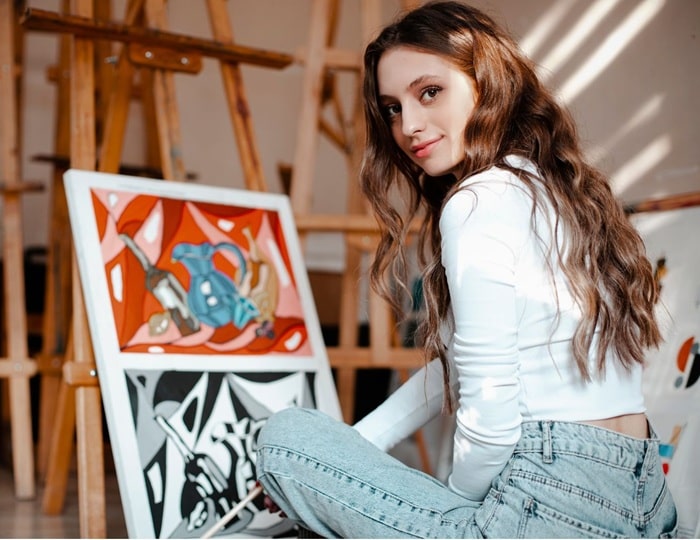Let’s be real for a hot minute – being creative isn’t just about making great art anymore. (I work as an SEO content writer, but I’ve been an artist my whole life – believe me, I know. 🫠) If you want people to actually find and pay for your work, you’ve got to learn how to market yourself as a creative. Whether you’re a painter, designer, writer, or any kind of maker, getting your name out there is part of the job now.
The good news? You don’t need to be a marketing expert to start showing up like a pro. In this post, we’ll break down the basics of personal branding for creatives, easy digital marketing for artists, and simple ways to share your work without feeling pushy or fake. If you’re ready to get seen, get noticed, and start building a real audience, let’s jump in.
| This page contains affiliate links. If you purchase through our links, we get a commission at no cost to you. Read the full disclosure here. |
Why market yourself as a creative
If you’re a creative, your talent deserves to be seen – and the internet is the best place to make that happen. When you market yourself as a creative online, you open doors to new opportunities, dream clients, and even passive income. It’s not about bragging; it’s about showing up and sharing what you’re great at.
Self-promotion for creatives might feel awkward at first, I get that – as an artist as well, I also can feel a bit weirded out about it. But it is a game-changer. The right people can’t support your work if they don’t know it exists! And in today’s world, building a portfolio online is one of the smartest moves you can make. It gives you a professional space to show off your style, skills, and story – all in one place.
So whether you want to land more freelance gigs, sell your art, or grow your audience, marketing your talent isn’t optional – it’s essential. And the best part? You don’t have to be famous or have a huge budget to start. Just be real, be visible, and stay consistent.
Step 1 to market yourself as a creative: Start with your personal brand
Your personal brand is more than just a logo or color palette. It’s the story, style, and energy you bring to your work. Think of it as your creative fingerprint.
Artist branding strategy tips:
- Define your creative identity: What do you create and why?
- Be consistent: Use the same voice, tone, and visuals across your platforms.
- Know your audience: Who is your work for? What is your creative niche?
Smart tip: Focusing on a specific creative niche builds stronger connections. It also positions you as an expert and makes your marketing efforts more effective.
Trying to market to everyone can dilute your message, making it harder for people to understand what you offer.
And don’t forget: niche audiences are often more loyal and willing to support your creative business!
Case Study: Lisa Congdon
Lisa Congdon is a fine artist and illustrator who built a thriving business by staying true to her bold, colorful style and openly sharing her journey.
Her cohesive brand across her website, social media, and books shows how powerful personal branding for creatives can be.
Step 2 to market yourself as a creative: Build a killer online portfolio
If you don’t already have one, stop everything and start building a creative portfolio. Your online portfolio is your digital storefront – it tells the world who you are and what you can do.
What to include:
- Your best work (curated, not crammed)
- A clear bio or about page
- Contact info
- Testimonials, if you have them
- Optional: blog, behind-the-scenes, or process videos
You can use platforms like Squarespace, Wix, or Webflow for sleek, mobile-friendly sites. For designers, Behance or Dribbble can also serve as part of an online presence for designers.
If you prefer more customization options and control over your own online portfolio without giving up the professionalism you need to market yourself as a creative, building your own self-hosted WordPress website might be the best option.
If you want to start building your creative online portfolio right now in a super beginner-friendly platform that will give you a free domain name + unlimited emails @ your domain (think about how professional and creative you can get!) for only $35.40 on your first year, I couldn’t recommend DreamHost enough.
I’ve been a DreamHost client for 5 years and can affirm that their customer support is fast and qualified, and the speed and security are just GREAT!
But if you try and don’t like it – fear nothing! DreamHost gives you a 30-day money-back guarantee, so you can rest assured you’ll only remain their client if YOU are truly satisfied. So I’m inviting you in this very moment to go build your creative online storefront with DreamHost for only $35.40! Then please let me know your experience with DreamHost – I’m confident you’ll love it!
✅ Here are the best platforms for showcasing creative portfolios:
- LinkedIn – Professional network to showcase creative achievements and attract business clients.
- Behance – Ideal for designers, illustrators, and photographers to showcase visual work.
- Personal website – The right choice for creatives who want to customize every single detail of their portfolio and have an all-in-one space. You can start a website with a professional email at your domain for less than $36 with DreamHost.
- Dribbble – Great for designers, especially in UI/UX, branding, and animation.
- Instagram – Perfect for building a creative brand and engaging directly with followers.
- TikTok – If your niche demographic consists of a younger crowd, short video content might be the best choice!
- Adobe Portfolio – A professional option that integrates with Adobe Creative Cloud.
- Squarespace / Wix – Easy-to-use website builders for creating personalized portfolio sites.
- Etsy – Ideal for selling handmade or digital creative products alongside a portfolio.
- ArtStation – Popular for concept artists, illustrators, and 3D artists.
Smart tip: The right platform may also depend on your niche and where your ideal audience spends time!
Step 3 of self-promotion for creatives: Get active on social media (Strategically)
Social media for artists isn’t just about posting your work – it’s about connection. Choose 1–3 platforms where your audience hangs out and shows up regularly.
Creative self-promotion tips for social media:
- Share your work in progress
- Post short behind-the-scenes clips
- Talk about your inspirations and creative process
- Use relevant hashtags
- Engage with your followers and peers
Case Study: Lo Harris
Lo Harris, a digital artist, uses Instagram and TikTok to not only showcase her art but to educate, inspire, and share her personal story.
Step 4: Use content marketing to share your expertise as a creative
Content marketing for artists is all about creating value-based content that educates, entertains, or inspires your audience.
Ideas to try:
- Write blog posts about your process or tips for beginners. You can start a self-hosted professional blog for only $35.40 in your first year with DreamHost – and you even get a domain name for free!
- Create YouTube tutorials or studio vlogs
- Start a podcast or guest on others
- Offer infographics on Pinterest (always including your personal branding, of course!)
This builds authority, trust, and a deeper connection with your audience. It also helps with SEO for artist websites, making it easier for new fans and clients to discover you.
Related: How to Monetize Your Skills, Knowledge & Talents Online
Step 5 of self-marketing for artists: Grow your email list (Yes, really)
Email might feel old-school, but it’s still one of the most powerful tools in digital marketing for artists. Unlike social media, you own your email list. Emailing your online followers and fans can also feel more personal, providing a deeper connection between creator and fan/consumer. For that reason, nurturing an email list is a must-have to market yourself as a creator or artist.
Email marketing for creatives tips:
- Share updates, product launches, and personal insights
- Offer a freebie (printable, behind-the-scenes video, mini-guide)
- Send regular newsletters (biweekly or monthly is great)
Step 6 of how to market yourself as an artist: Collaborate and connect
Collaboration and influencer marketing can fast-track your visibility. It’s a smart, effective, and common way to market yourself as a creative. Partner with other creatives, influencers, or small brands that share your vibe.
You can also build your network through art communities, both online and in person. Think Discord servers, Facebook groups, or local meetups.
Related: Best Platforms to Monetize Skills and Make Money Online
Case Study: The Art Snacks Box Collab
Several artists have boosted their reach by collaborating with Art Snacks, a monthly art supply subscription. They created unboxing videos, live demos, and tutorials, introducing their work to thousands of new fans.
Step 7 of freelance creative marketing: Explore multiple promotion tactics
There isn’t one magic way to promote yourself as a creative – the best strategy is a mix of methods tailored to your goals.
Online art promotion tactics:
- Launch a print shop or digital store on Etsy or Gumroad
- Offer commissions with clear packages
- Start a blog to share valuable content with your target audience
- Share client work (with permission)
- Start a YouTube channel
- Run giveaways or challenges to increase engagement
These tactics are perfect for freelance creative marketing and help build a reputation over time.
Step 8 of how to market yourself as a creative: Stay visible and consistent
Consistency matters more than perfection. You don’t have to be everywhere, but you do need to show up regularly where it counts.
Promoting your creative skills online checklist:
- Participate in online challenges or community events
- Post 2–3 times/week on your main social platform
- Update your portfolio quarterly
- Send at least one newsletter per month
How to stay consistent as an artist?
Artists and creatives often struggle with consistency because their work is deeply personal, making fear of judgment or perfectionism hard to shake. Add to that the emotional energy creation demands, and marketing can feel overwhelming or inauthentic.
That’s why balancing creativity with self-promotion takes mindset shifts and intentional habits.
But remember: staying consistent as an artist doesn’t mean creating nonstop – it means building steady habits that support your growth. Here’s how to keep showing up without burning out:
- Set a realistic schedule – Create art at a pace you can sustain, whether that’s daily, weekly, or a few times a month.
- Stick to your style – Let your visual voice evolve naturally, but keep a recognizable thread throughout your work.
- Batch your content – Take a day to prepare posts, schedule newsletters, or update your portfolio in bulk.
- Use reminders and routines – Treat your creative time like a commitment. Block it off like any other appointment.
- Track your progress – Document what you’ve finished to stay motivated and see how far you’ve come.
- Be kind to yourself – Life happens. What matters most is showing up again.
Consistency is about rhythm, not perfection.
Step 9 of how to market yourself as a creative: Measure, tweak, and improve
Keep track of what’s working and what’s not. Use analytics on Instagram, your website, or email software to see what content resonates most.
Don’t be afraid to experiment with different artist marketing ideas. Marketing is creative too!
Content marketing for artists and self-promoting creatives
When 51% of content consumption comes from organic search, content marketing becomes a smart, low-cost way to market yourself as a creative while providing real value to your audience.
After all, who likes getting invasive ads when checking friends and family or searching for entertainment on social media?
Content marketing helps creatives promote their services by showcasing their expertise, building trust, and attracting the right audience.
I should also mention that it’s a path to passive income. 🫡
By sharing valuable content – like tutorials, behind-the-scenes posts, or tips – on blogs, social media, or YouTube, creatives can demonstrate their skills and personality in a natural, engaging way.
This positions creatives as go-to professionals in their niche, increases visibility online, and encourages potential clients to reach out.
✅ Best content marketing practices to market yourself as a creative:
Learn SEO (SEO for artist websites)
SEO (Search Engine Optimization) uses keywords – the exact phrases people type into search engines – to help your content show up in search results.
It makes your content easier to find on Google, helping you attract more of the right audience without paying for ads.
By adding these keywords naturally to your blog posts, portfolio pages, or product descriptions, you increase your chances of being discovered.
The perks?
More traffic, more visibility, and more clients or sales over time – all from content you’ve already created. It’s smart, sustainable, and essential for growing online.
Your SEO strategy must include every online platform you use to promote your creative skills – social media, blogs, YouTube Channels, marketplaces, etc. You can use platforms such as KWFinder to check keyword search volume and the level of difficulty to rank for.
SEO quick wins:
- Use keywords naturally in your website, blog posts, and product listings (e.g., “monetize creative talents online,” “best ways to sell digital art,” etc.).
- Structure your content with clear headers and subheadings for reader and search visibility.
- Internally link to other relevant articles or resources on your site to boost SEO and user engagement. For example, link your post on “How to launch your first digital product” to provide further guidance.
Start a YouTube Channel to build an art community online
As a self-promoting creative online, a YouTube channel is one of the most powerful ways to showcase your talent, build trust, and attract a loyal audience through content marketing.
Video is highly engaging and helps people connect with your personality and skills. It works especially well for extroverts and those comfortable on camera – but even if you’re camera-shy, many creators succeed with voiceovers, animations, or anonymous formats.
The perks?
Increased visibility, authority in your niche, more traffic to your services or products, and the potential to earn through ads, sponsorships, or affiliate marketing. YouTube builds your brand while growing your business.
Start a self-hosted blog as an online art promotion tactic
A self-hosted blog gives creatives full control over their content, brand, and monetization.
Unlike free platforms, a self-hosted blog lets you customize everything and earn with high-paying ad networks like Mediavine (which offers a higher RPM than Google AdSense). It’s a powerful tool for content marketing – boosting SEO, showcasing expertise, and attracting ideal clients or customers. Best of all, starting one isn’t expensive, even for beginners.
Here’s an example list of blog post types that creatives can write to do content marketing effectively – these help showcase expertise, build trust, and attract potential clients or customers:
✍️ Blog post ideas to market yourself as a creative:
- Tutorials & How-Tos
- “How to design a logo in under 1 hour (Step-by-step)”
- Show your creative process and establish yourself as an expert.
- Behind-the-Scenes
- “What a day in my life as a freelance illustrator looks like”
- Help readers connect with your personality and workflow.
- Case Studies or Project Breakdowns
- “How I designed a brand identity for a sustainable skincare brand”
- Demonstrates real-world experience and problem-solving skills.
- Tips & Advice
- “5 Things I wish I knew before becoming a freelance writer”
- Share insights to help your audience while building authority.
- Tool & Resource Reviews
- “My favorite free tools for digital artists in 2025”
- “Why investing in professional photography boosts your brand”
- Educate potential clients and position your services as the solution.
- “10 color palettes I’m loving this season (and why they work)”
- Fun, shareable content that reinforces your style and taste.
By creating this kind of content regularly, creatives can drive organic traffic (aka free traffic), build trust, and turn readers into clients or buyers.
| 🚀 Ready to take control of your creative content and income? DreamHost offers reliable hosting, a free domain name, unlimited domain emails, and a 30-day money-back guarantee – perfect for launching your creative blog with freedom and flexibility! |
Email marketing for creatives
Want loyal supporters who actually see your content? Start building your email list today!
An email list gives creatives who want to make money online a direct line to fans and customers – without relying on algorithms.
It’s one of the most effective content marketing tools for building relationships, promoting your work, and driving sales.
With email, you stay top of mind and can share updates, launches, or tips straight to your audience’s inbox.
Pro tip: Offering a free resource like a digital art print, checklist, mini-course, or template makes it much easier to get people to subscribe.
Display testimonials (with permission, of course!)
Social proof builds instant trust and credibility.
Real feedback from happy clients shows that you deliver results and makes it easier for new customers to say yes.
And don’t be shy!
Ask your clients to share their experiences. A short quote or review can go a long way in boosting conversions, attracting new work, and reinforcing your reputation. Testimonials are simple, powerful content marketing tools that speak louder than any self-promotion.
Marketing yourself as a creative doesn’t have to be a pain in the neck
To market yourself as a creative effectively, you need to embrace the fact that your work has value – and so does your voice. With a mix of self-promotion for artists, storytelling, and smart digital tactics, you can build a lasting presence that feels good and gets results.
It doesn’t have to be a bad – or even traumatic – experience. You don’t need to do it all at once. Start where you are, use what you have, and grow from there. Your next opportunity could be one post, one email, or one DM away.
You’ve got this.
How to market yourself as a creative: Self-promotion for artists FAQ
Define what makes your work unique – your style, voice, and values. Choose visuals (colors, fonts, logo) that reflect that identity. Use the same tone and look across your website, social media, and content. Branding yourself as a creative is about being consistent, memorable, and true to who you are.
To get noticed as a small artist, share your work consistently, tell your story, and connect with your audience. Use social media wisely, join art communities, and keep your portfolio updated. Engage, collaborate, and don’t be afraid to promote yourself – visibility grows when you show up and stay true to your style.
Independent artists promote themselves by sharing their work online, building a strong portfolio, and using social media to connect with their audience. They grow email lists, collaborate with others, join creative communities, and stay consistent with their message and style. It’s all about showing up, being authentic, and making their art easy to discover.
Showcase your best work in a clean, updated portfolio. Share behind-the-scenes and client projects on social media. Engage with other creatives and potential clients. Use platforms like Behance, LinkedIn, and Instagram. Build an email list and stay visible. Promoting yourself as a designer is about being consistent, confident, and easy to find.
Share your work consistently online, build a strong portfolio, and tell your story. Use social media to connect, not just post. Start an email list, join art communities, and don’t be afraid to talk about your process. Self-promotion is just showing up, being real, and reminding people why your art matters.
Artists brand themselves by sharing their unique style, story, and message consistently across platforms. They choose visuals and a tone that reflect their creative identity, build a strong portfolio, and show up online with purpose. The key is staying authentic while making it easy for people to recognize and connect with their work.
Artists are called brands because their work, style, personality, and message form a recognizable identity – just like a brand. It’s how people remember, connect with, and talk about them. In today’s world, being an artist isn’t just about creating art – it’s also about building a presence that stands out and stays consistent.
Introduce yourself as a brand by clearly sharing who you are, what you create, and what makes your work unique. Keep it simple, confident, and consistent across your platforms. Use your voice, visuals, and story to make a strong first impression that feels true to you.

READ NEXT:
Easy Beginner-Friendly e-Commerce Platforms for Side Hustle in 2025






